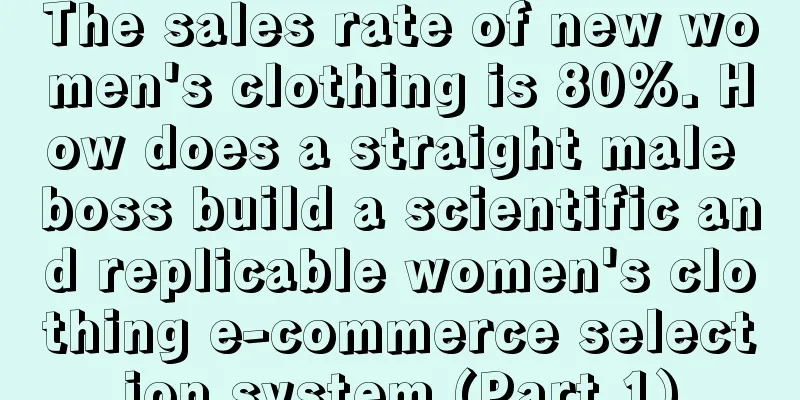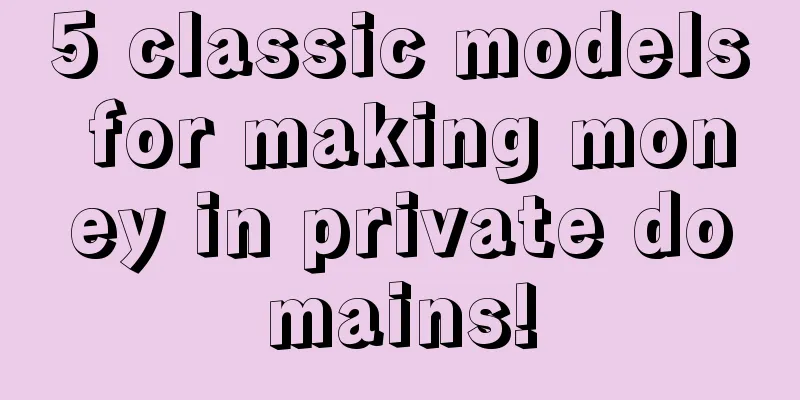The sales rate of new women's clothing is 80%. How does a straight male boss build a scientific and replicable women's clothing e-commerce selection system (Part 1)

There are relatively few articles on the market about women's clothing selection, mainly because this category is both complex and highly random (women's clothing is influenced by multiple factors such as personal aesthetics, weather, fashion, market, consumer tastes, economic changes, etc.), so it is difficult to summarize experience. As a straight man and a non-female user, I have been working in the e-commerce women's clothing industry for several years. Combining my previous experience in the Internet industry and summarizing it through practice, I have gradually developed a relatively simple and easy-to-use method for selecting styles. I think it has certain reference value, so I would like to share it here. If you are a fashion expert or a blogger, you have a strong sense of clothing and unique ideas and aesthetics. Then you don’t need to read this article again, just trust your intuition and vision. But if you are a dabbler who knows a little about women's clothing but not that much, then I believe this article will definitely help you, allowing you to gradually establish a stable and replicable method of selecting styles among the vast number of women's clothing styles. 1. Several realities that need to be recognized before choosing a modelBefore I talk about choosing a model, I want to clarify a few facts. First of all, the underlying logic of women's clothing selection is a combination of rational and emotional thinking, neither of which is indispensable. Rational thinking means that we must first do market analysis, analyze styles, analyze the overall market, analyze categories, analyze price ranges, and analyze competitors. Emotional thinking refers to the aesthetic preference for style, the grasp of color, the grasp of version, and the grasp of elements in specific selection. Rational thinking is more like a framework, and emotional thinking must be output within the framework of rational thinking. Why do I emphasize this point? Because whether it is women's clothing e-commerce or offline clothing stores, this business is done by many female friends, and a problem that everyone often makes is: There is only emotion, no rationality. Many female friends are indeed good at matching and dressing, and are often praised by their girlfriends for their good looks. This can easily lead to blind self-confidence. Instead of analyzing the market, style, overall situation, and rhythm, they directly select styles, purchase goods, and make purchases based on their own aesthetics. As a result, once the products are put on the shelves for sale, they find that their own dressing aesthetics may not be accepted by the market, and few sales are made, leading to direct business failure. There are a large number of posts on Xiaohongshu about offline women's clothing stores going out of business, and one of the main reasons is that the store owners' aesthetic taste and selection are completely deviated from the market. Therefore, no matter how good your aesthetic vision is or how stylish your clothing style is, you must express it within the framework of rational thinking. Then there are some people who don't bother to choose products and just upload them mindlessly. They just upload whatever products are available on the market. This is mostly done by male friends. They upload dozens or hundreds of products every day, using a large number of products to test the algorithm probability of the platform and see whichever one comes out is the best. This distribution model is not e-commerce, but just moving bricks. The store is not selling women's clothing, but a grocery store. If a women's clothing store wants to grow bigger, it needs to constantly improve its aesthetics, vision, style selection, product assembly, and matching capabilities. However, this brick-moving mode will not hone the above skills. Some people don’t pay attention to choosing styles, but pay more attention to testing styles. I can’t make a choice, so I might as well let the system test it. I can select a bunch of models, run ads to test them, and then I’ll promote the model that performs best. This method is actually not wrong, but for those who are just starting to do e-commerce, first of all, they don’t know how to test the products, how to test them, and how to judge the data; secondly, they don’t have the money to test the products, and the cost of testing is too high. For example, if you have 20 designs and you test them all, and one product gets 100 clicks and each click costs 0.5 cents, that means you have to spend 50 yuan on testing one product, and 1,000 yuan for 20 products. If none of these 20 products succeeds, the money will be wasted. So even though there are advertising testing assistance operations, I think it is also necessary to constantly hone my ability to select products. A good eye for selecting products + advertising-assisted testing will achieve twice the result with half the effort. The benefits of women's clothing are: Once your selection method, experience, and vision are honed, and combined with continuous corrections in market sales, the longer the time, the easier it will be to form an experience advantage, which is what we call a sharp eye, and the more you look, the more accurate you will be. Finally, it is about style and product selection in e-commerce, which is a practical science. Practical science means that theories and methods are not important. The most important thing is to constantly obtain market feedback and make corrections through practice. Therefore, in the initial stage, don’t worry about whether you have made the wrong choice, a bad choice, or the wrong choice. Instead, you should quickly obtain market feedback through rounds of launches and carry out the next round of optimization. Therefore, this article only provides a direction and basic methods for everyone. I will also remind you in the article that only practice can make corrections possible! 2. Anchoring the market stylePlease understand that we are doing women's clothing e-commerce to sell clothes and to make money, and we must grasp the market demand when selling goods. Many people who make women's clothing do not like to grasp the market demand, but like to "grasp" their own needs. They think that a certain style is good-looking or a certain type of clothing is comfortable to wear, and they think that everyone should like it. Women's clothing entrepreneurs with this idea will eventually die a miserable death. Therefore, our selection of models must always be market-oriented, and we must first anchor several directions through the market. Women's clothing selection must first anchor the market style At this point, someone will definitely interrupt me and ask, "Hey! Isn't product positioning all about targeting the crowd first?" First determine who you are selling to, what age group, what tier of small city, how much monthly income girls, etc. It is difficult for most people to target the right groups of people and to deliver effective products to those groups when they initially select products. Because the user group of women's clothing is extremely large, everyone's needs are divergent, and it is difficult to fit them into a single group. For example, if you want to create a women's clothing brand, you can target white-collar working women aged 24 to 30 in first-tier cities. This positioning seems very accurate at first glance, but it is actually very broad. Look at your female colleagues and female friends in the company. Even if they are of similar age, white-collar women, and from first-tier cities, their dressing styles are very different. Even among the group of college girls, this highly concrete and unified group, the clothes they wear are ever-changing, some are introverted, some are extroverted, some are pretty, some are ordinary, some have high living expenses, some have low living expenses, some are conservative, some are cheerful, some are from first-tier cities, and some are from second-tier cities. Therefore, it is difficult to implement if you select products based on target group. But your positioning style is different. The clothing style is basically stable and clear. A stable clothing style will attract a group of target users, thereby automatically completing user positioning. There are actually many styles of women's clothing: Korean style, everyday style, French style, romantic style, hot girl style, European and American style, trendy brand style, simple style, celebrity style and so on. So what kind of style should we focus on? The key is to find the combination between [popular style] and [your aesthetic control]. It is important to create a popular style. After all, clothes are a basic demand category. As long as the masses like it, it will easily sell out. What I am most afraid of is that many entrepreneurs start out with a very "gelu" (Northeastern dialect) style. For example, Gothic style, hot girl style, and dress style. The people who can wear these clothes are a minority, and the consumer group is very small. It is like looking for a needle in a haystack to find users. How can you possibly sell them? At present, the mainstream market styles of women's clothing in my country's e-commerce are actually the following categories:
In addition to the above main styles, there are also some British style, hot girl style, new Chinese style, Hong Kong style, etc. as auxiliary styles. At least in the beginning, we want to create a popular style. Popular style means extremely high demand, and you can get market feedback quickly. If you can’t sell your popular style products, then it’s not a product problem, but may be a problem with the visuals, promotion, matching, or price range; if you can’t sell your niche style products, you may have to suspect that there are too few people who buy products of this style, the demand is too low, and it’s not easy to get traffic. Of course, I want to emphasize here that this style is not unchanging. Do you remember what I said before? Style selection is a practical science, and we need to practice it constantly. Once you have anchored a style, you will also find some pitfalls and make continuous corrections. 3. Anchor the market categoryYou think a certain style is good, it is a popular style, you like it too and have worn it. The next thing to anchor is the large-cap category. We have always been talking about e-commerce product selection, and this product selection actually includes two levels. One is [select category], the other is [select product]. For women's clothing, choosing the right category is as important as choosing the product. You think the weather is getting hot, but you are still selling pants; the weather is getting cold, but you are still selling dresses. This is the wrong category choice. In a sense, choosing the right category is half the battle in selecting women's clothing. If you want to choose a good category, you need to understand the categories that rank at the top in market sales every month in history. Take the following figure as an example. The following figure is the sales ranking of each category on a certain e-commerce platform in June last year: As you can see, in June, dresses, T-shirts, pants and other categories had the highest sales. What does high sales mean? It means there is a huge market demand. Everyone is buying this thing, so if you sell it, as long as the product is not too bad, there will definitely be conversions. Many novices do not consider the market conditions when selecting products in the initial stage. They choose products based entirely on their own preferences. In the end, the products they choose are out of season and there is no strong market demand. How can they be sold? Another benefit of selling products in the market is: When the product you choose is in line with the market trend and your product sells well, it is easy to get the recommended traffic and free traffic provided by the platform. Let’s continue talking about dresses. In June, market demand was particularly strong and consumers all needed to buy dresses. If one of your dresses sold out at this time, the platform would naturally recommend your product to more consumers. Because the demand is huge and your product is very good, it will be easier to gain accelerated potential energy. The product category you make is niche and the demand is not high. Even if you sell dozens of pieces, the platform will not give you too much traffic because the demand is too low. Of course, our resources are limited, and that doesn’t mean we have to do all the top-ranked categories. In fact, every time we select products, it is enough if we can cover the top 3 or 5 categories in terms of sales. There are also some categories that you find unsuitable and difficult to do after you actually do them (as I said before, selection is a practical science, and you will find various problems after practice). For example, in June, the growth trend of fashion sun protection clothing was particularly strong, but you couldn't do it because the competition in this category was fierce. You couldn't compete with big brands, online celebrity stores, or supply chain factories. Of course, the category data given to us by the market is very vague and is only a rough approximation. For example, the market tells us that the sales of pants are very high. So what kind of pants are they? Long pants or shorts? Thin pants? Thick pants? Casual pants? Or suit pants? These big markets won't tell you that much detail, so you need to do more detailed research. 4. Anchoring product segments through competitionAt this time, you need to see what categories the benchmark stores are selling. After you have anchored your style, you can find stores on the platform that have done a good job of this style to learn from and benchmark against. You can find four or five big online celebrity stores, brand stores, medium-sized stores, etc. to imitate and learn from. Similarly, the stores you benchmark against will also change as you grow. You see, it’s still the same sentence:
Thanks to the fact that many stores have classification modules, we can check what products they had at this time last year. Below is a store classification module that allows you to view the product styles it had last year. You can do some statistics to know more clearly what the category direction given by the overall market is like when broken down into specific stores. Should the shirt be short-sleeved or long-sleeved; should the pants be shorts or long pants; should the dress be short-sleeved or suspenders; should the skirt be long or short? After visiting a few more stores, you can roughly list the main categories and detailed categories for your selection. If you make the next selection with this category orientation, you will not be confused. Otherwise, when faced with a huge number of styles, you will be very confused. This one is fine, that one is fine, and the more you choose, the more confused you will become. 5. Anchoring the market trendinessWomen's clothing is a fashion business, and no consumer wants to wear clothes that are tacky and low-quality. But you have to grasp this fashion level well. If it is too advanced, consumers will not be able to accept it. After all, there are not so many real fashion trendsetters. If it is too backward, consumers will think you are too rustic, they will not like it and will not want to buy it. If we divide fashion into several levels, leading, following, and lagging, our grasp of fashion level in choosing styles should be between leading, following, and lagging. What leads the fashion are the catwalks, designer brands, and super fashion gurus. We don't need to pay attention to these contents, because even if we watch them, it is meaningless. You don't have the ability to deconstruct fashion. The time difference between catwalk fashion and ordinary people's wear is generally two years. At the same time, there is a lot of disassembly of elements, and it is difficult for non-professionals to absorb the essence. So this is why I don’t recommend watching shows or fashion week shows. It’s hard for most ordinary people like me to follow this because we are not very sensitive and have limited digestion ability. But some people are very good at it! They are the various influencers, KOLs, and influencers on Xiaohongshu and Douyin. They have the ability to grasp, deconstruct, digest and re-output fashion. Otherwise they wouldn’t become an internet celebrity. At the same time, they also have the ability to guide consumers' vision. At this stage, consumers' purchasing needs will also refer to the recommendations of KOLs, so we only need to find KOLs who match our own style and aesthetics and recommend more popular products, refer to their styles, and grasp the fashion sense, and we will basically get a good reference. For example, when summer comes and we want to promote white skirts, we can collect all the high-quality content about skirts recommended by KOLs on the entire network by taking screenshots. When we choose styles, we can refer to the styles promoted by KOLs, and basically we will be at a stage where we can follow the fashion, be more popular and be accepted by the market. You may say that it is so tiring to select styles like this every time and to analyze them one by one. Generally speaking, it will be more tiring at the beginning, but as you choose more and more, the subsequent statistical and analysis work will be greatly reduced because your vision is constantly being trained. Having said that, you can see that I emphasize more on the framework and directional content, and personal aesthetics has not yet fully come in. I emphasize again that the outer rational framework is very important, because our framework matches the market. Only when your aesthetics matches the market, if your aesthetics are good, the market will magnify it and the product will sell well. If your aesthetics are bad, the product will sell poorly, which will urge you to constantly make corrections and improvements, so as to reach a level corresponding to the market. Without a framework, your aesthetic will diverge and collide with the market, and you will never be able to find a sales entry point, and the more you choose, the more confused you will become. Now that the framework is set up, how does personal aesthetics come into play? We will continue in the next article. Author: Liu Weidong WeChat public account: Liu Weidong's Entrepreneurship Notes (ID: liu17701793970) This article was originally published by @刘玮冬创业手记 on Operation Party. Any reproduction without permission is prohibited. The title image is from Unsplash, based on the CC0 protocol. |
<<: Return offline to offline, new retail is coming to an end
>>: TikTok e-commerce creates stars, will it create another Dong Yuhui?
Recommend
What factors make up the cost of cross-border e-commerce products? How to set prices?
Cross-border e-commerce makes profits by selling g...
What products are good for cross-border e-commerce? Any good recommendations?
After e-commerce became popular, WeChat business a...
It’s really cool to use DeepSeek to make Xiaohongshu
In today's era of rapid development of social ...
Taobao's full introduction of WeChat Pay does not actually bring much growth, but it can attract some goodwill
Although the full introduction of WeChat Pay by Ta...
How to get coupons on Amazon Global Shopping? How to use them?
When shopping on Amazon Global Shopping, you can s...
How to fill out an Amazon prepaid return label? What is a return label?
As one of the world's largest e-commerce platf...
Is exchanging RMB for foreign currency settlement or purchase of foreign exchange? What is the difference between the two?
In international trade and travel, the exchange of...
After launching the “9.9” offer, can Taobao no longer handle the situation?
This article starts from Taobao’s recent move to r...
How to redesign the business model for Qiegao so that the Qiegao uncle can sell 1,000 pieces of Qiegao every day?
Qiegao has long been a "one-size-fits-all ass...
Can Wish deliver goods locally? How does Wish deliver goods?
Some of the merchants who have opened stores on th...
[Mid-year review] Frontline traders’ in-depth thinking on marketing
In today's rapidly changing business environme...
Is it really reliable to open a store on Amazon? Is it easy to do it now?
The reason why so many people open online stores i...
Mixue lucky bags have been exposed for over 60 million times! The Spring Festival marketing offensive has begun, which direction will the brands bet on?
For brands, the Spring Festival is a good time to ...
I spent 5,000 yuan to buy 20 courses on selling good products on Douyin, but none of them was useful!
The author spent 5,000 yuan to buy more than 20 Do...
Here it comes! Super detailed real-life examples of user portraits
When promoting or positioning a brand, the term us...









